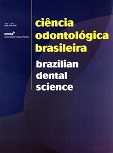Influência da experiência profissional no diagnóstico radiográfico de cáries
DOI:
https://doi.org/10.14295/bds.2006.v9i1.285Abstract
O objetivo neste trabalho foi avaliar a influência do treinamento e da experiência do examinador no diagnóstico radiográfico de cáries proximais. Para isso, oitenta dentes hígidos ou portadores de lesões cariosas nas faces proximais foram selecionados para a montagem de phantoms, dos quais foram obtidas radiografias interproximais. Estas radiografias foram avaliadas quanto à presença de cáries, por três examinadores. O primeiro examinador realizou duas avaliações: uma antes de iniciar a disciplina de Radiologia, assistindo apenas a uma aula sobre diagnóstico de cáries (treinamento teórico), e outra após seis meses, quando concluiu a disciplina. O segundo examinador avaliou as radiografias apenas após ter cursado a disciplina. O terceiro foi um radiologista. Os dentes foram seccionados e analisados microscopicamente (padrão-ouro). Para cada avaliação foram determinados os índices de sensibilidade, especificidade e acurácia. O teste Kappa foi utilizado para avaliar a concordância intra e interexaminador. Os resultados indicaram que na avaliação inicial do primeiro examinador a sensibilidade foi 0,72 e a especificidade 0,25, indicando um alto número de respostas falso-positivas. Após o curso de Radiologia, os resultados foram semelhantes para os dois alunos. O especialista apresentou os maiores valores de especificidade (0,85) e acurácia (0,69). Os valores Kappa indicaram uma concordância variando de muito leve a moderada. Concluiu-se que a experiência do examinador influenciou no diagnóstico radiográfico da cárie dentária: com o aumento do conhecimento houve uma redução dos resultados falso-negativos e um aumento da acurácia.Downloads
Downloads
Published
How to Cite
Issue
Section
License
Brazilian Dental Science uses the Creative Commons (CC-BY 4.0) license, thus preserving the integrity of articles in an open access environment. The journal allows the author to retain publishing rights without restrictions.
=================




























